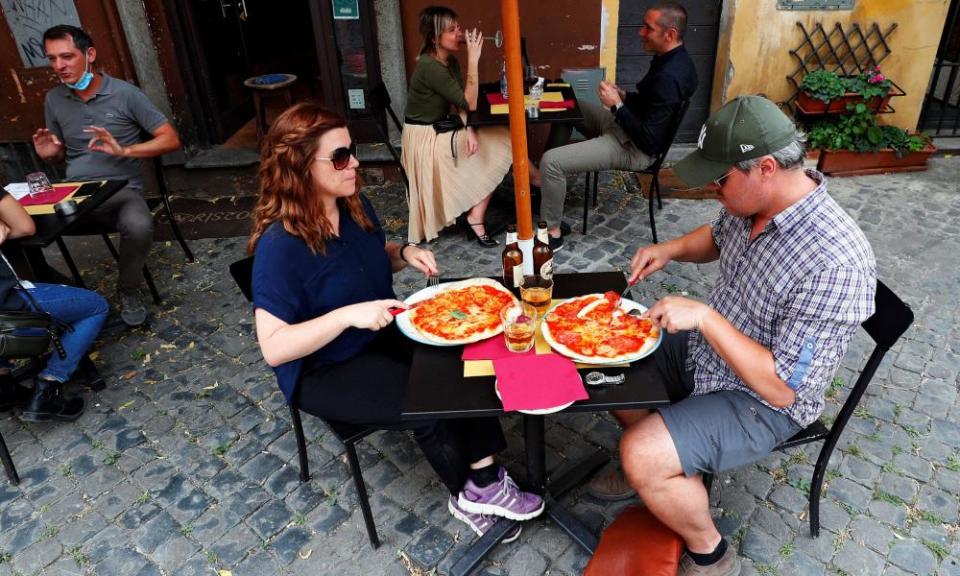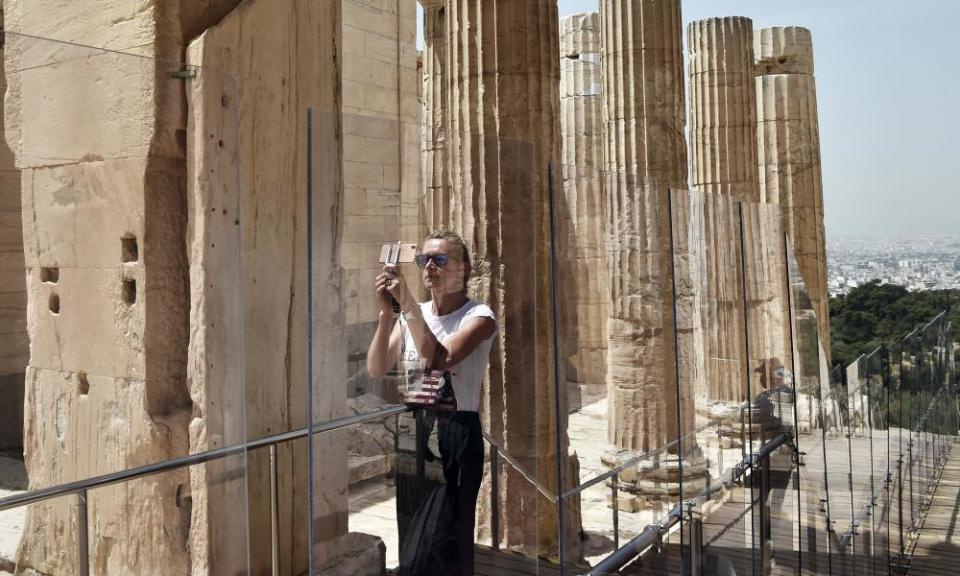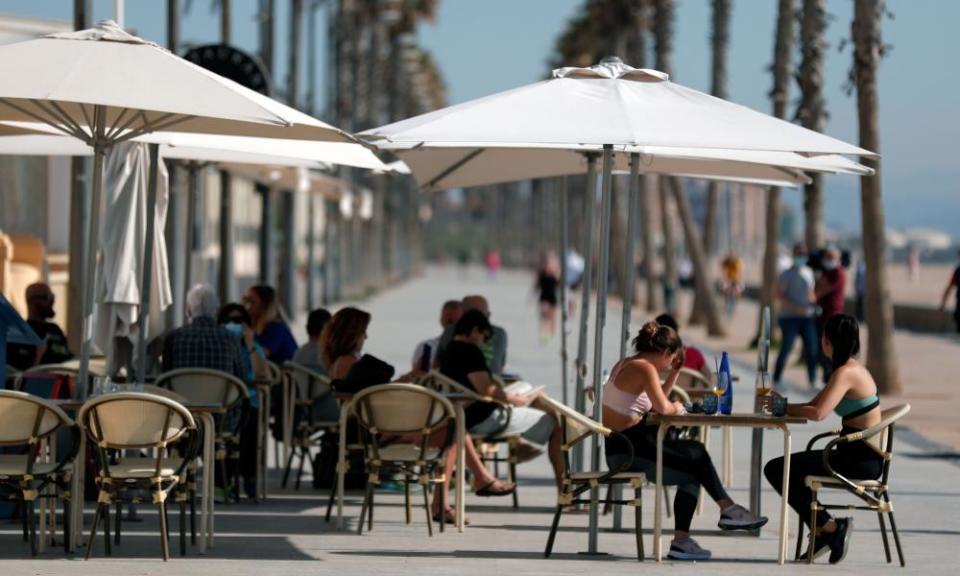Global report: Italy reopens cafes as Spain prepares for return of tourists

Italians enjoyed their first meal out for two months on Monday, as the country eased lockdown restrictions, with bars, restaurants and cafes back in business and St Peter’s basilica in the Vatican open for visitors.
After a gruelling lockdown period during the coronavirus pandemic, Italy was once again able to sip cappuccino and cold beers – albeit at a physical distance from other customers.
“I haven’t worked for two and a half months. It’s a beautiful, exciting day,” Valentino Casanova, a barman in Caffe Canova in Rome’s central Piazza del Popolo, told Reuters.
The prime minister, Giuseppe Conte, described the ending of curbs as a “calculated risk”. Italy was the first European country to go into full lockdown more than two months ago. It is now returning to a semi-normality, with hairdressers also returning to work on Monday.
A handful of visitors, including nuns, queued up outside St Peter’s for the first time since 10 March. Police officers wearing face masks checked temperatures before allowing them to enter. Masses in churches across Rome were also due to resume.
The World Health Organization (WHO) guidance on face masks has remained consistent during the coronavirus pandemic. It has stuck to the line that masks are for healthcare workers – not the public.
“Wearing a medical mask is one of the prevention measures that can limit the spread of certain respiratory viral diseases, including Covid-19. However, the use of a mask alone is insufficient to provide an adequate level of protection, and other measures should also be adopted,” the WHO has stated.
Nevertheless, as some countries have eased lockdown conditions, they have been making it mandatory to wear face coverings outside, as a way of trying to inhibit spread of the virus. This is in the belief that the face covering will prevent people who cough and sneeze ejecting the virus any great distance.
There is no robust scientific evidence – in the form of trials – that ordinary masks block the virus from infecting people who wear them. There is also concerns the public will not understand how to use a mask properly, and may get infected if they come into contact with the virus when they take it off and then touch their faces.
Also underlying the WHO’s concerns is the shortage of high-quality protective masks for frontline healthcare workers.
Nevertheless, masks do have a role when used by people who are already infected. It is accepted that they can block transmission to other people. Given that many people with Covid-19 do not show any symptoms for the first days after they are infected, masks clearly have a potential role to play, especially on crowded public transport as people return to work..
Sarah Boseley Health editor
Other southern European countries followed suit on Monday. Spain indicated that it would allow tourists to return at the end of June, while Greece welcomed the first visitors back to the Acropolis.
Workers in masks and plastic face shields stood around the archaeological site in Athens, reminding people to keep apart as they entered through turnstiles. The country has recorded only 156 deaths from Covid-19.
The president, Katerina Sakellaropoulou, visited the Acropolis on Monday. She hailed it as “a world monument that continues to inspire with its marbles shining under the sun”.

Greeks are now allowed to travel freely and to visit the country’s two biggest islands, Crete and Evia. Shopping malls and zoos have reopened, together with sports facilities for those aged over 13. Wearing of masks is recommended but not compulsory, except on buses and trains.
In Spain, almost three-quarters of the country progressed to the second phase of lockdown de-escalation. Millions of people were able to meet up in groups of up to 10, and to have a drink or a meal on cafe and restaurant terraces.
The transport minister, José Luis Ábalos, said the country would end two-week quarantine restrictions at the end of June, and would fully reopen its borders. The move would take place at the same time internal travel restrictions were phased out.
“From late June, we’ll start the tourism activity, I hope,” Ábalos said. “We must make Spain an attractive country from the health point of view.”
Epidemics of infectious diseases behave in different ways but the 1918 influenza pandemic that killed more than 50 million people is regarded as a key example of a pandemic that occurred in multiple waves, with the latter more severe than the first. It has been replicated – albeit more mildly – in subsequent flu pandemics.
How and why multiple-wave outbreaks occur, and how subsequent waves of infection can be prevented, has become a staple of epidemiological modelling studies and pandemic preparation, which have looked at everything from social behaviour and health policy to vaccination and the buildup of community immunity, also known as herd immunity.
Is there evidence of coronavirus coming back in a second wave?
This is being watched very carefully. Without a vaccine, and with no widespread immunity to the new disease, one alarm is being sounded by the experience of Singapore, which has seen a sudden resurgence in infections despite being lauded for its early handling of the outbreak.
Although Singapore instituted a strong contact tracing system for its general population, the disease re-emerged in cramped dormitory accommodation used by thousands of foreign workers with inadequate hygiene facilities and shared canteens.
Singapore’s experience, although very specific, has demonstrated the ability of the disease to come back strongly in places where people are in close proximity and its ability to exploit any weakness in public health regimes set up to counter it.
What are experts worried about?
Conventional wisdom among scientists suggests second waves of resistant infections occur after the capacity for treatment and isolation becomes exhausted. In this case the concern is that the social and political consensus supporting lockdowns is being overtaken by public frustration and the urgent need to reopen economies.
The threat declines when susceptibility of the population to the disease falls below a certain threshold or when widespread vaccination becomes available.
In general terms the ratio of susceptible and immune individuals in a population at the end of one wave determines the potential magnitude of a subsequent wave. The worry right now is that with a vaccine still months away, and the real rate of infection only being guessed at, populations worldwide remain highly vulnerable to both resurgence and subsequent waves.
The Madrid region and the Barcelona metropolitan area remain in the preliminary phase of what the government has called “the transition towards the new normality”.
The health ministry said that despite “huge progress” in and around the capital, the region would not yet be able to join the 70% of the country in the next phase. People in Barcelona and parts of the Castilla y Léon region will also remain in phase 0 for the time being.
Spain recorded its lowest single-day death toll in two months on Sunday. The latest figures from the health ministry showed that 87 people had died from Covid-19 in the previous 24 hours, down from 102 the day before.
The country has confirmed 231,350 cases of the virus and reported 27,650 deaths. Over the weekend the prime minister, Pedro Sánchez, said his Socialist-led coalition would be seeking a final, month-long extension of the state of emergency that underpins one of the strictest lockdowns in Europe.

Meanwhile, Ireland took a cautious step on Monday towards easing its lockdown by allowing some businesses to reopen and up to four people from different households to meet as long as they respect physical distancing.
Gardening centres, hardware stores, bicycle repair shops and outdoor construction are among the handful of sectors cranking back to life. It is the first phase of a five-stage plan to lift restrictions spread out over three-week intervals, with the fifth and final phase starting on 10 August.
“We all need to approach the coming days with care and caution, and to show some collective cop-on,” said Simon Harris, the health minister, using an Irish term for common sense. “We want the shops to stay open, so there’s no need to rush down to your local DIY centre or garden shop today.”
On Sunday the country reported 64 new cases of Covid-19, the lowest daily figure since mid-March. Testing and contact tracing has expanded, bolstering confidence in the ability to monitor and contain outbreaks.

 Yahoo Sports
Yahoo Sports 